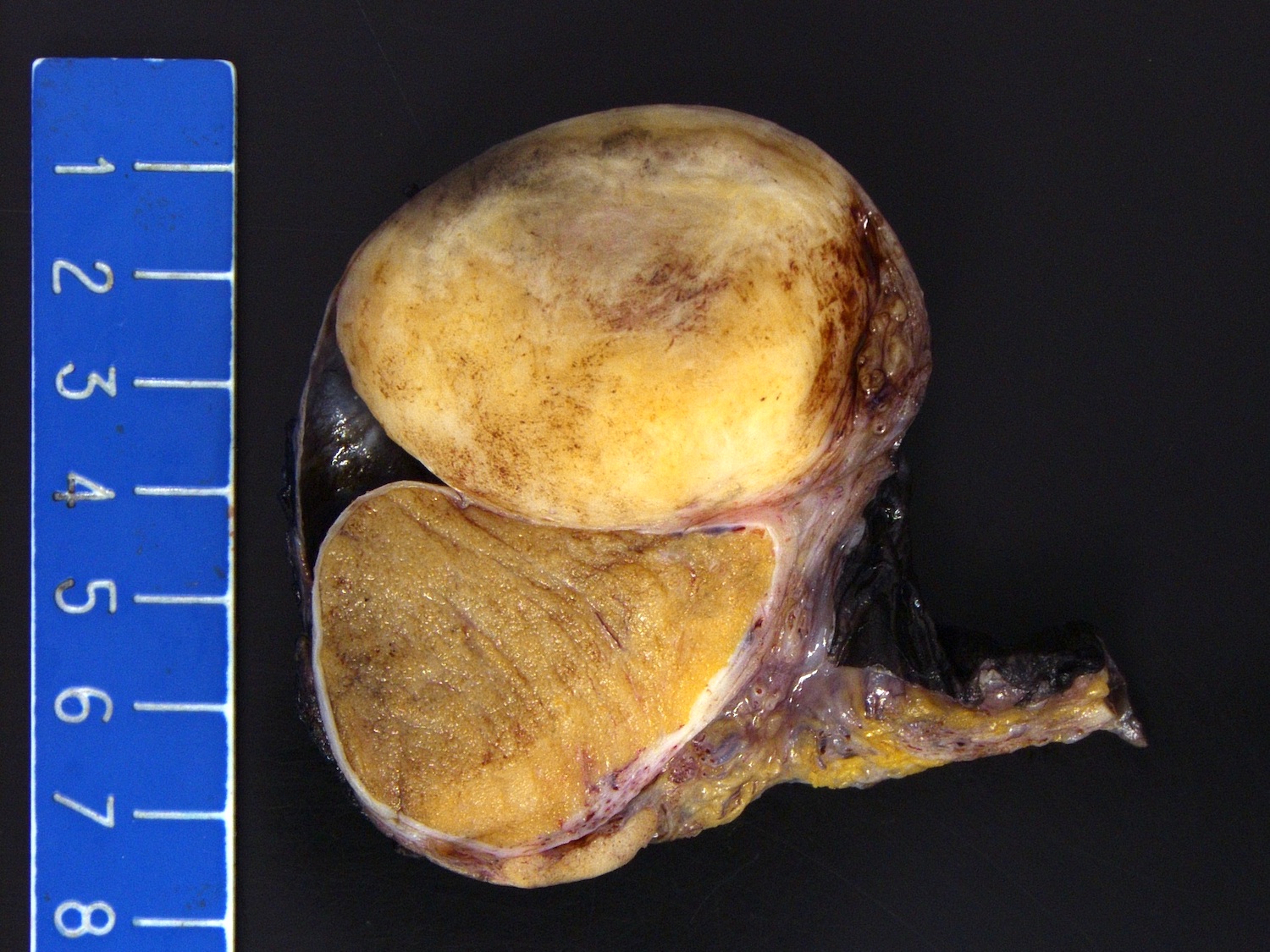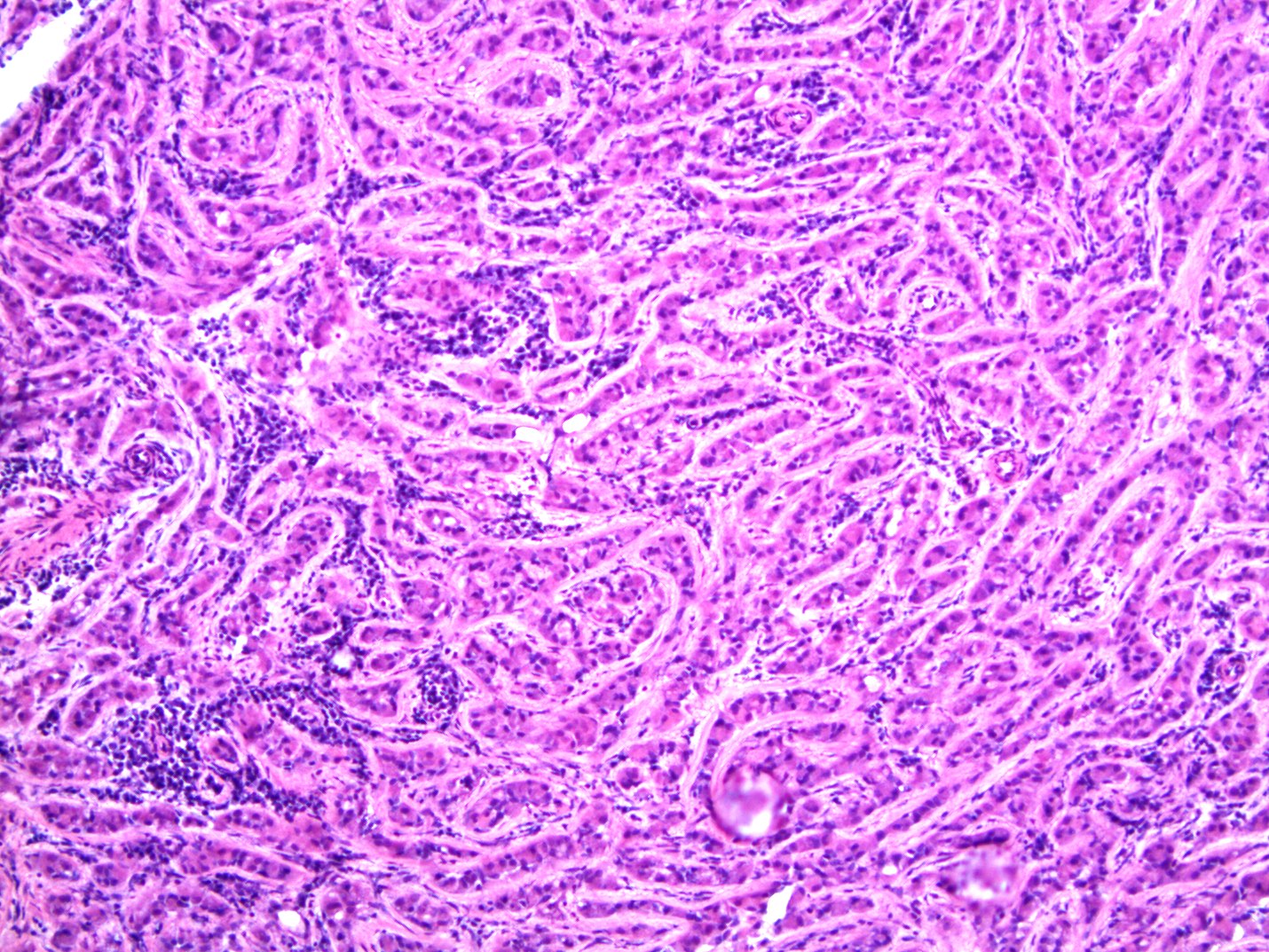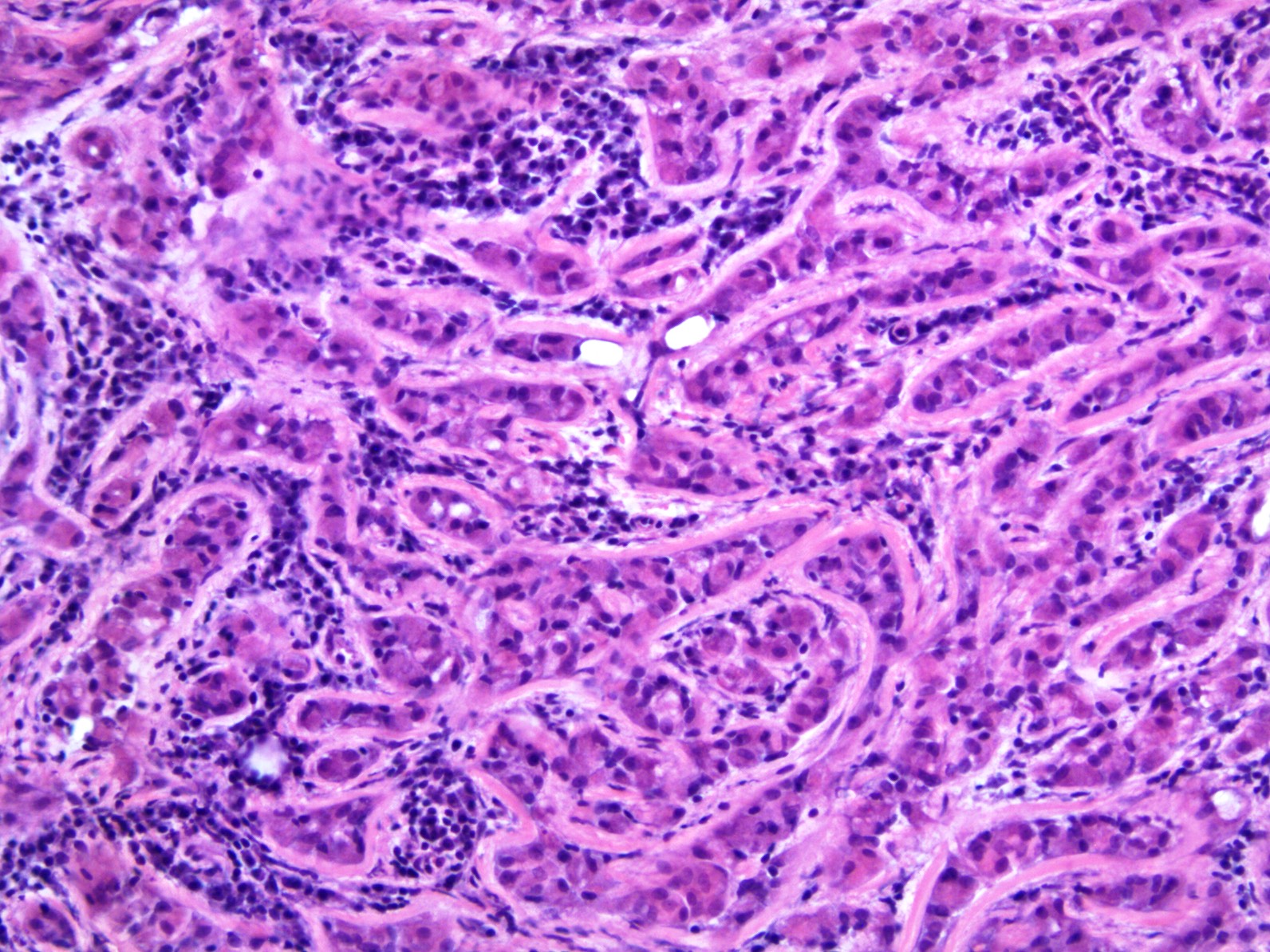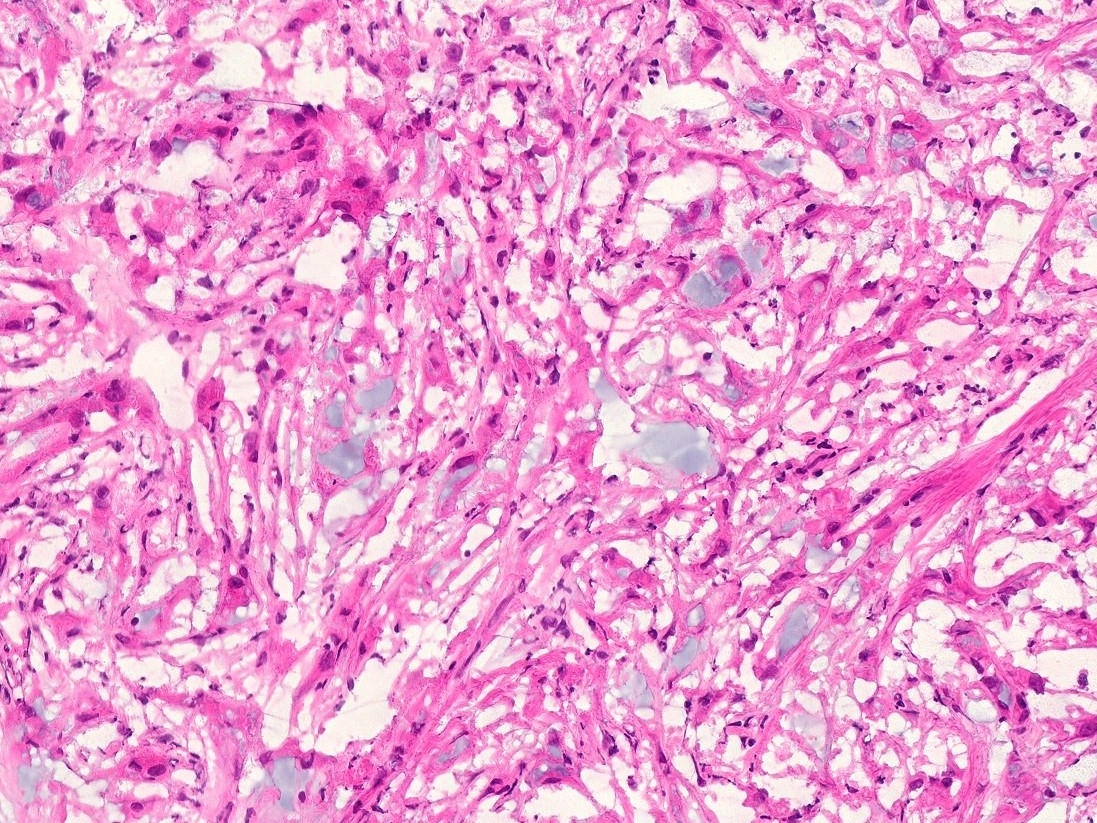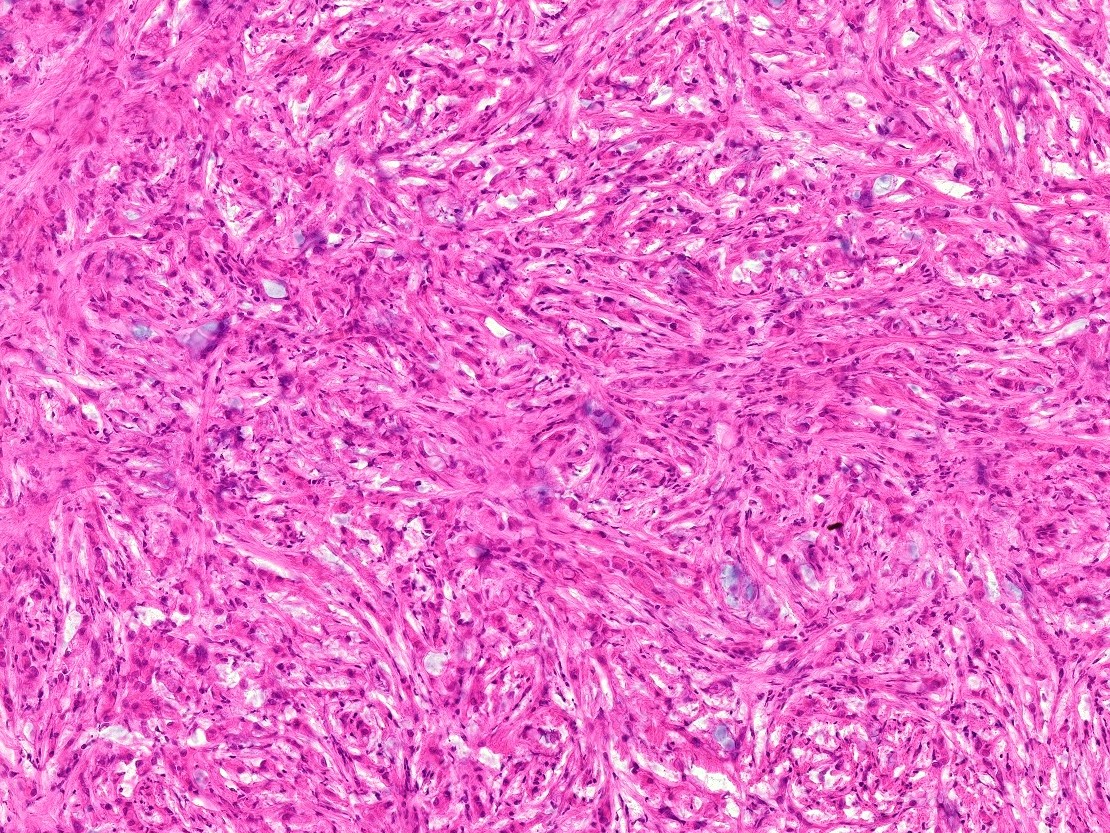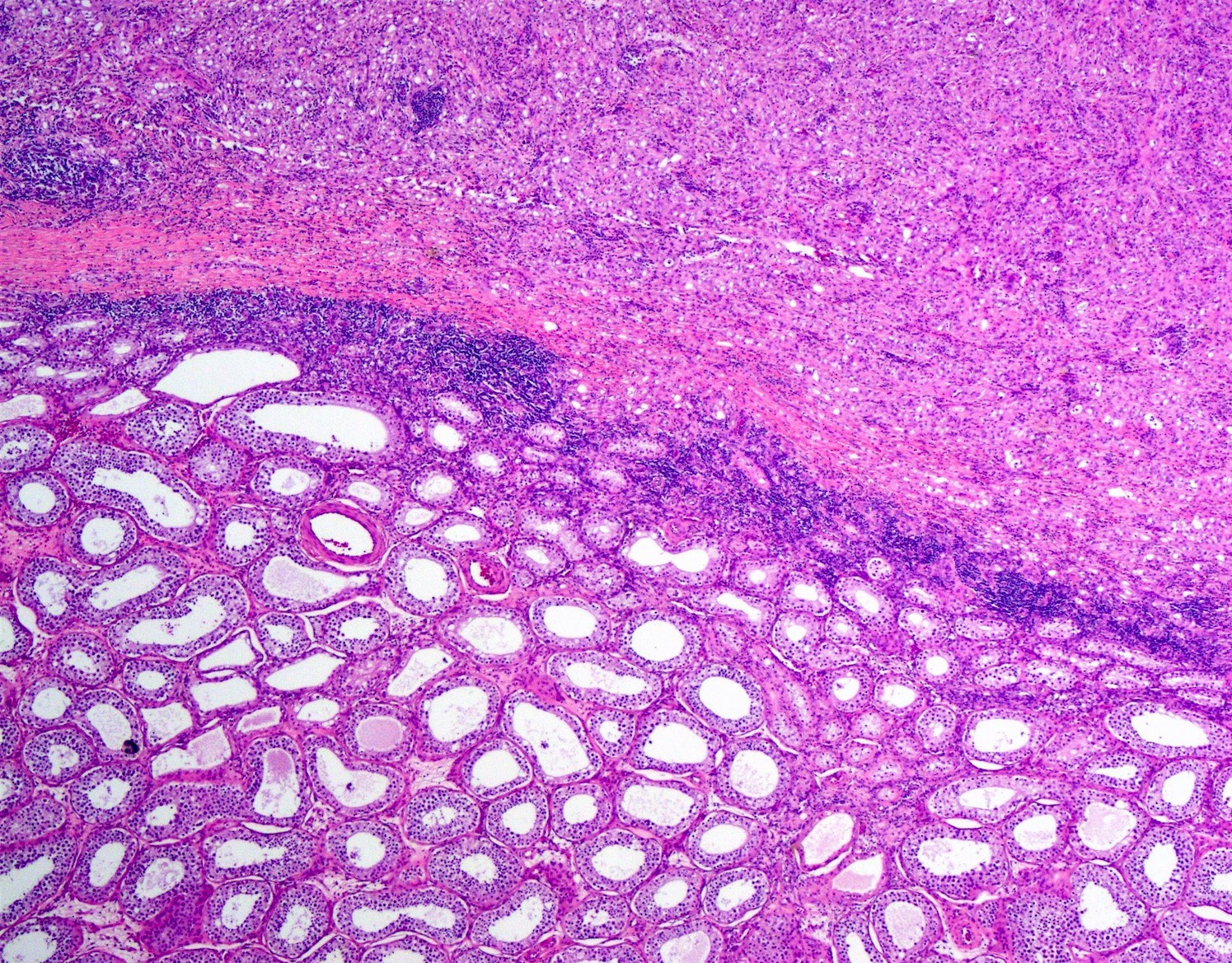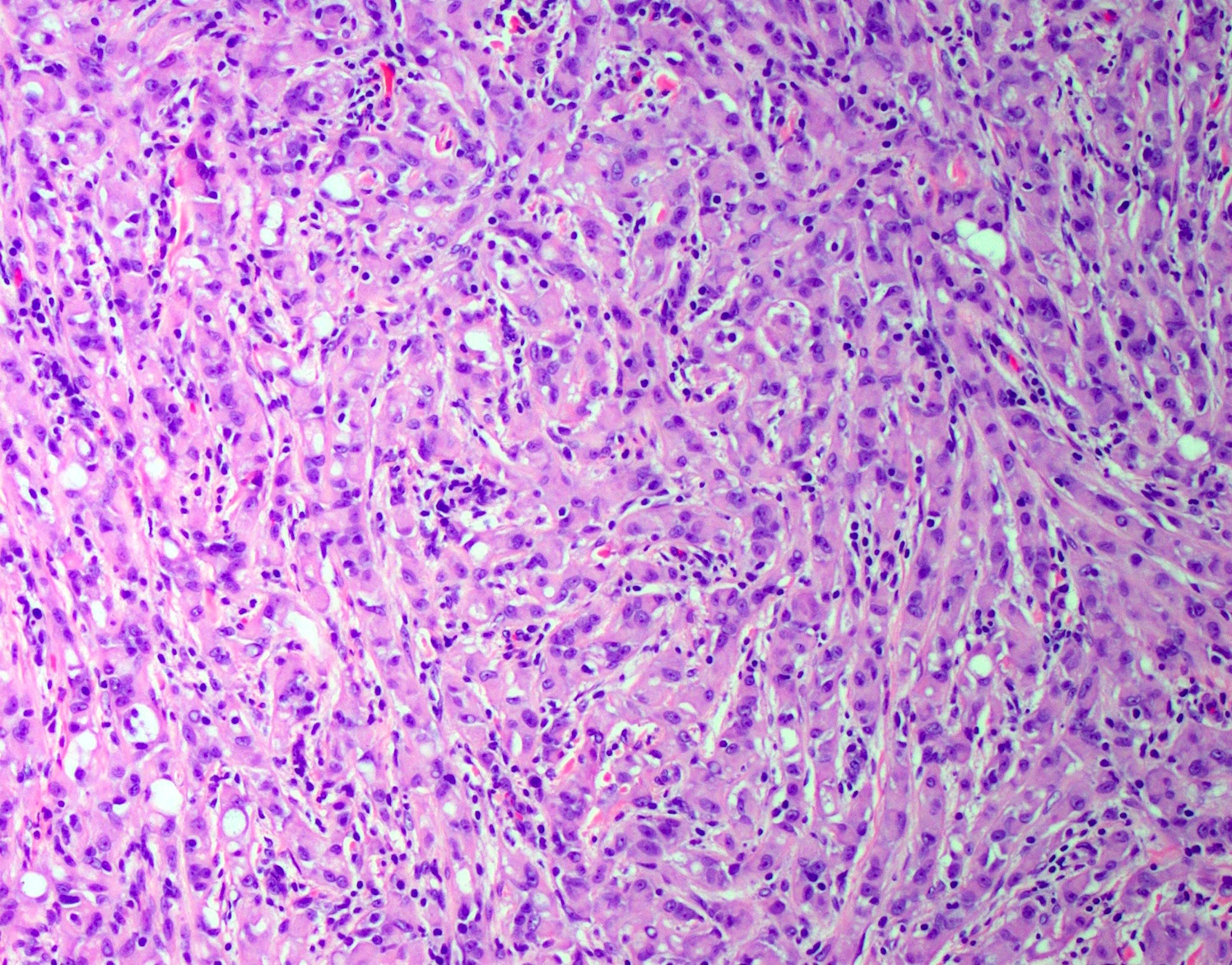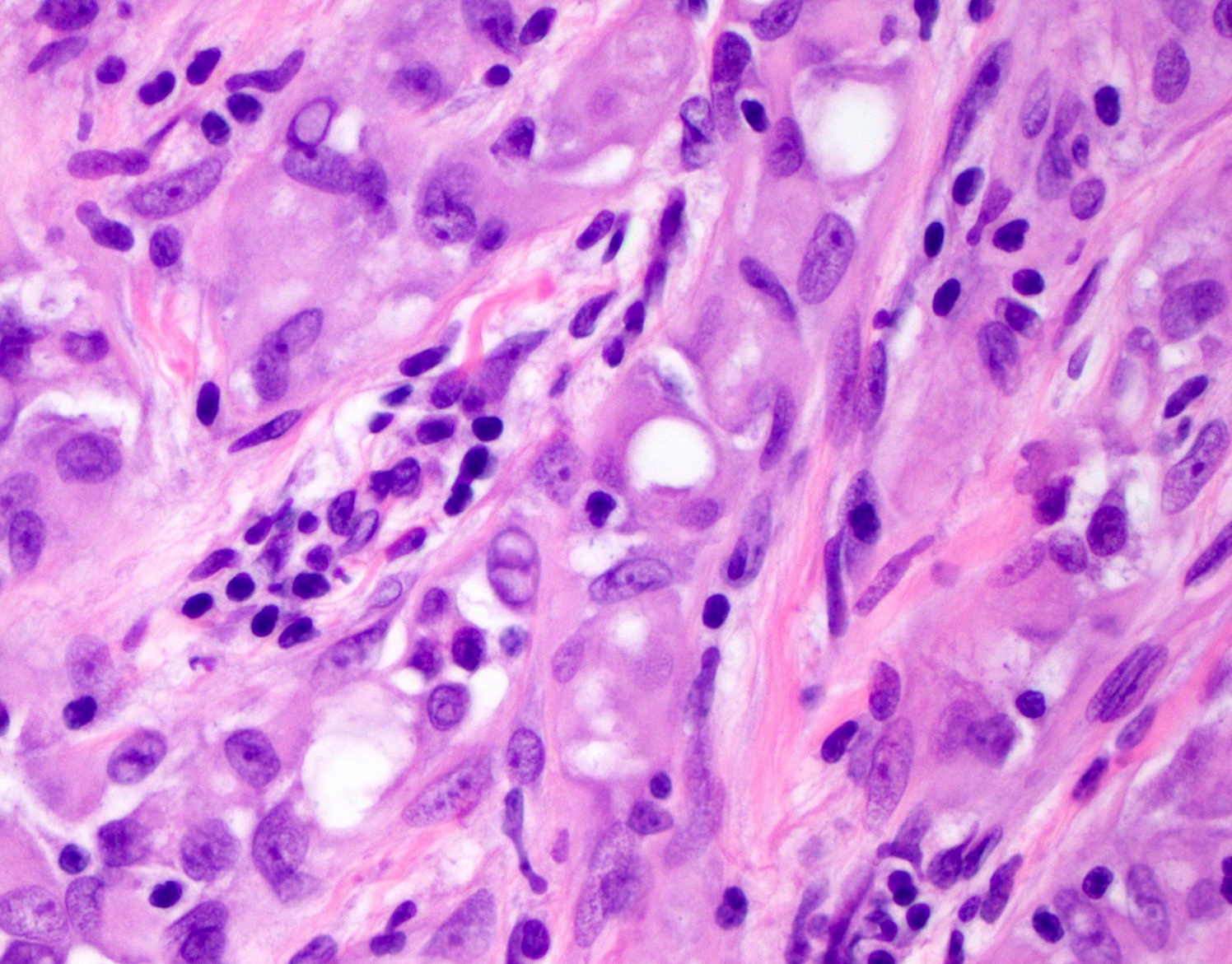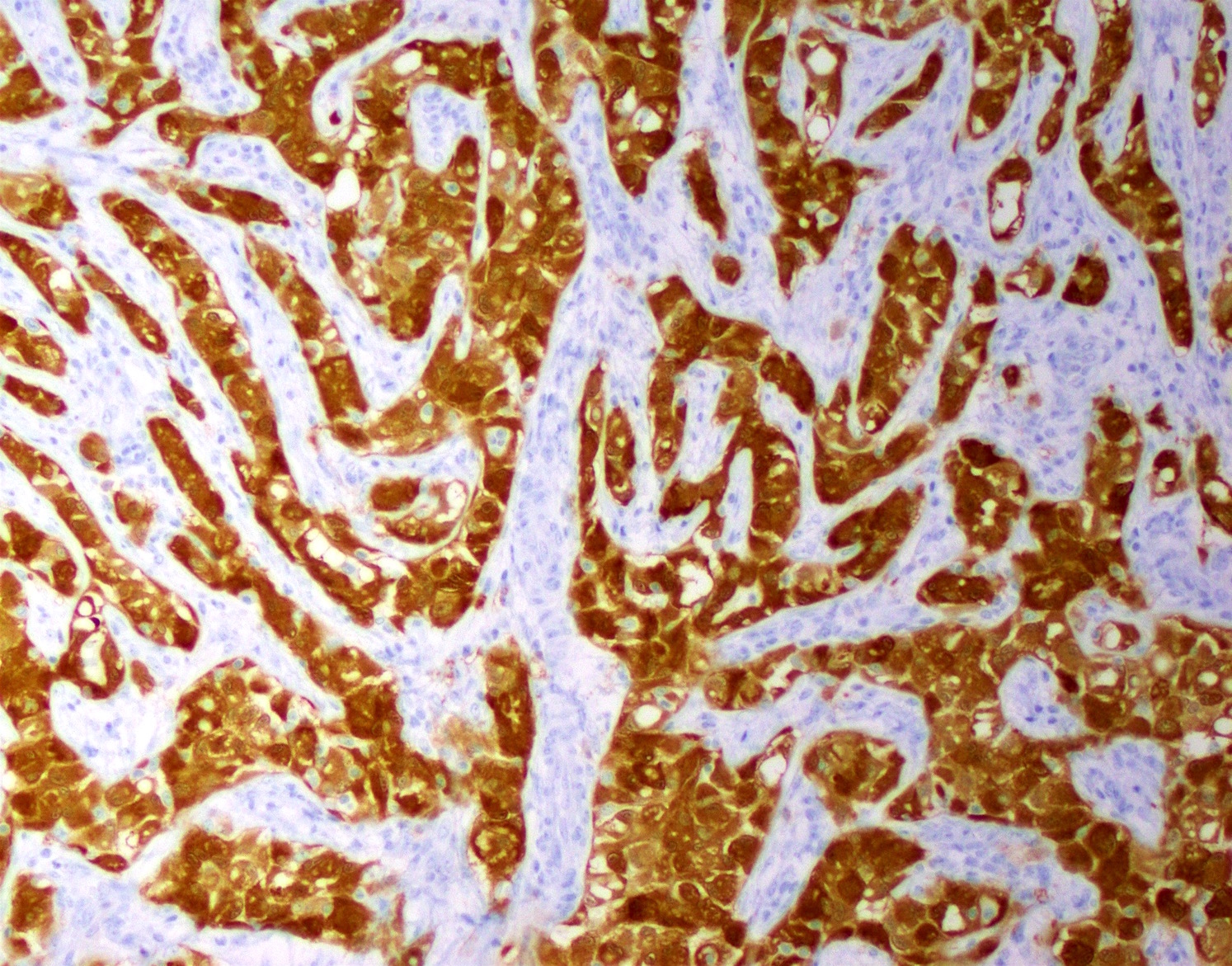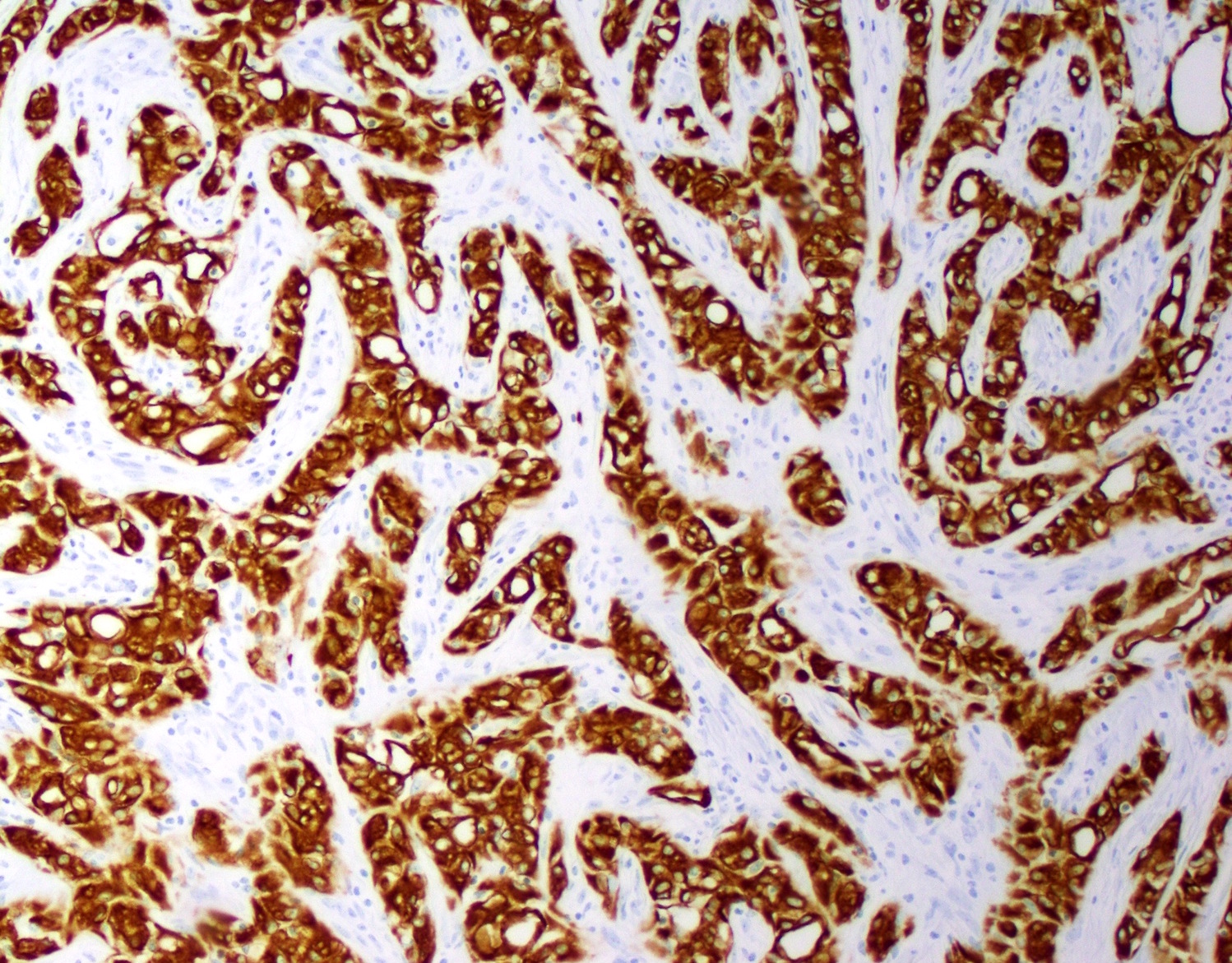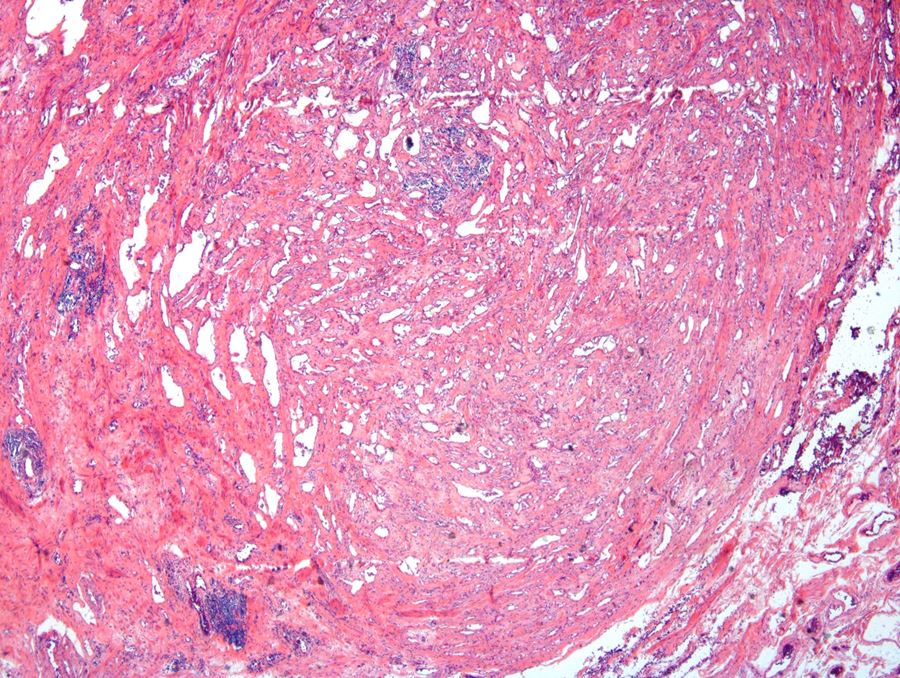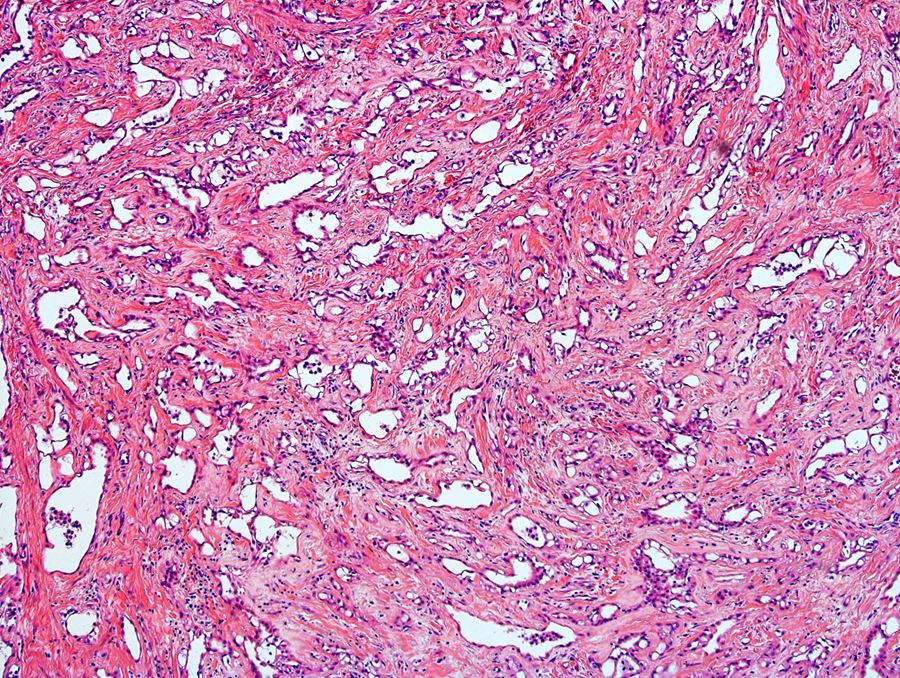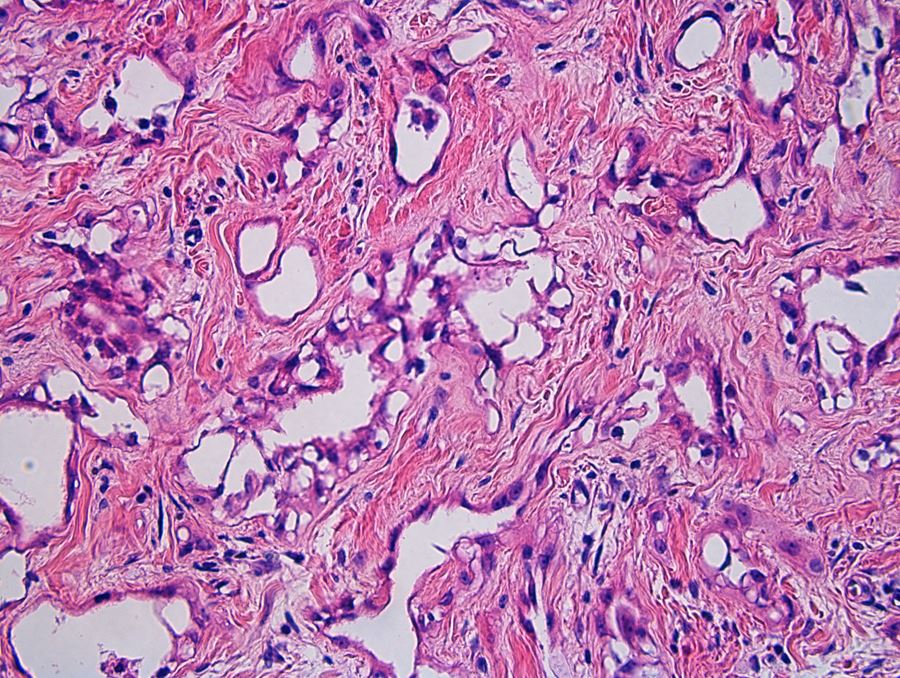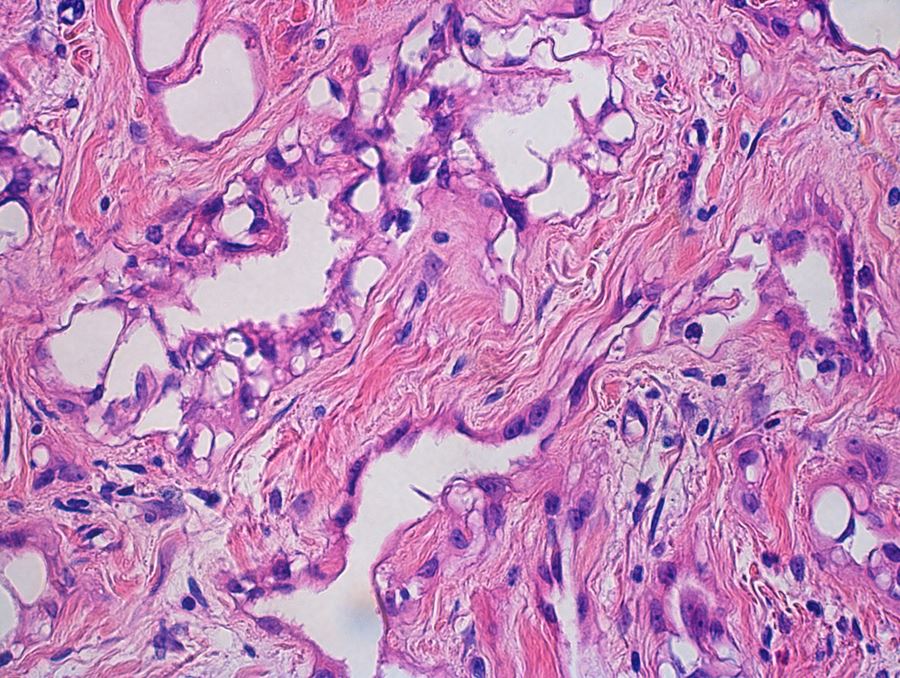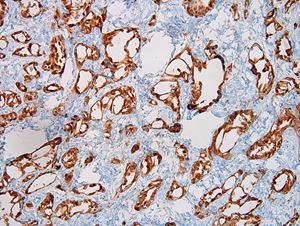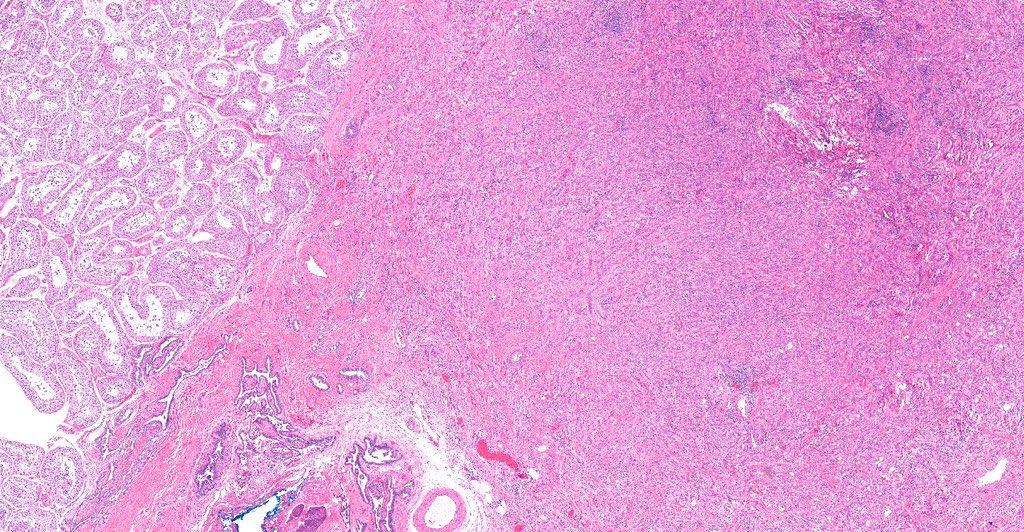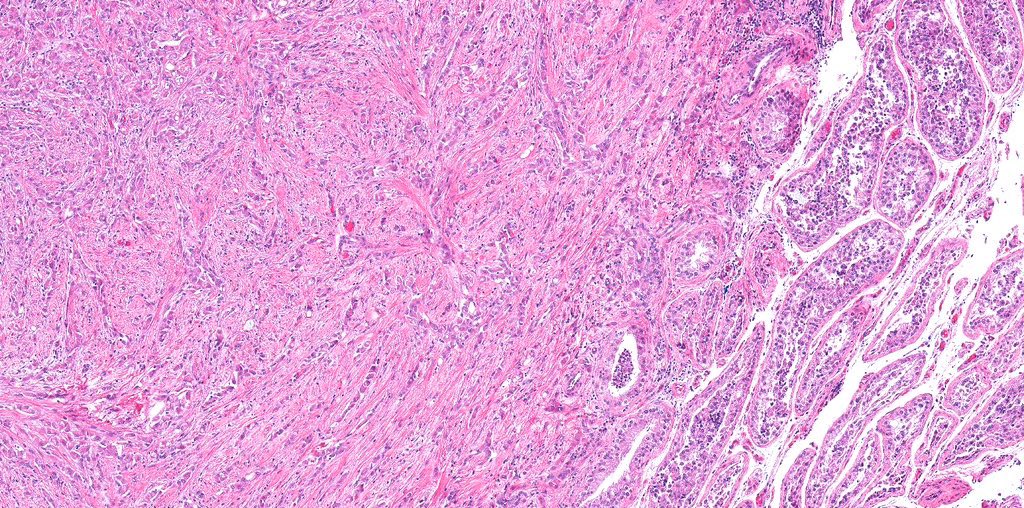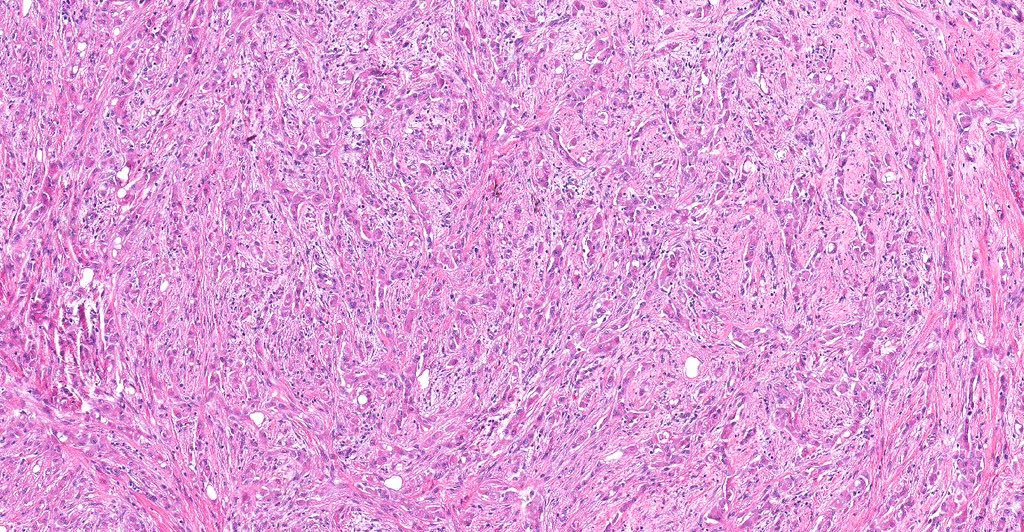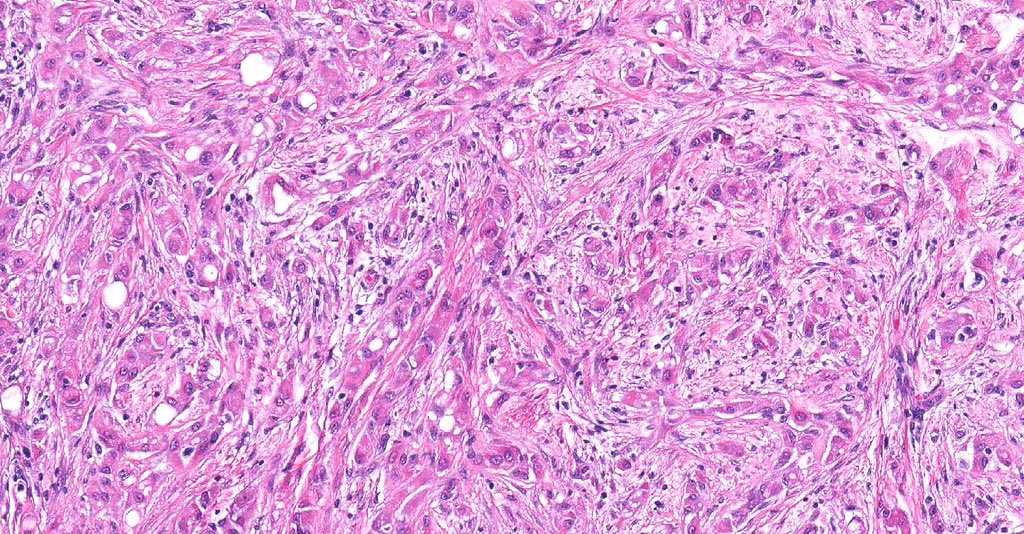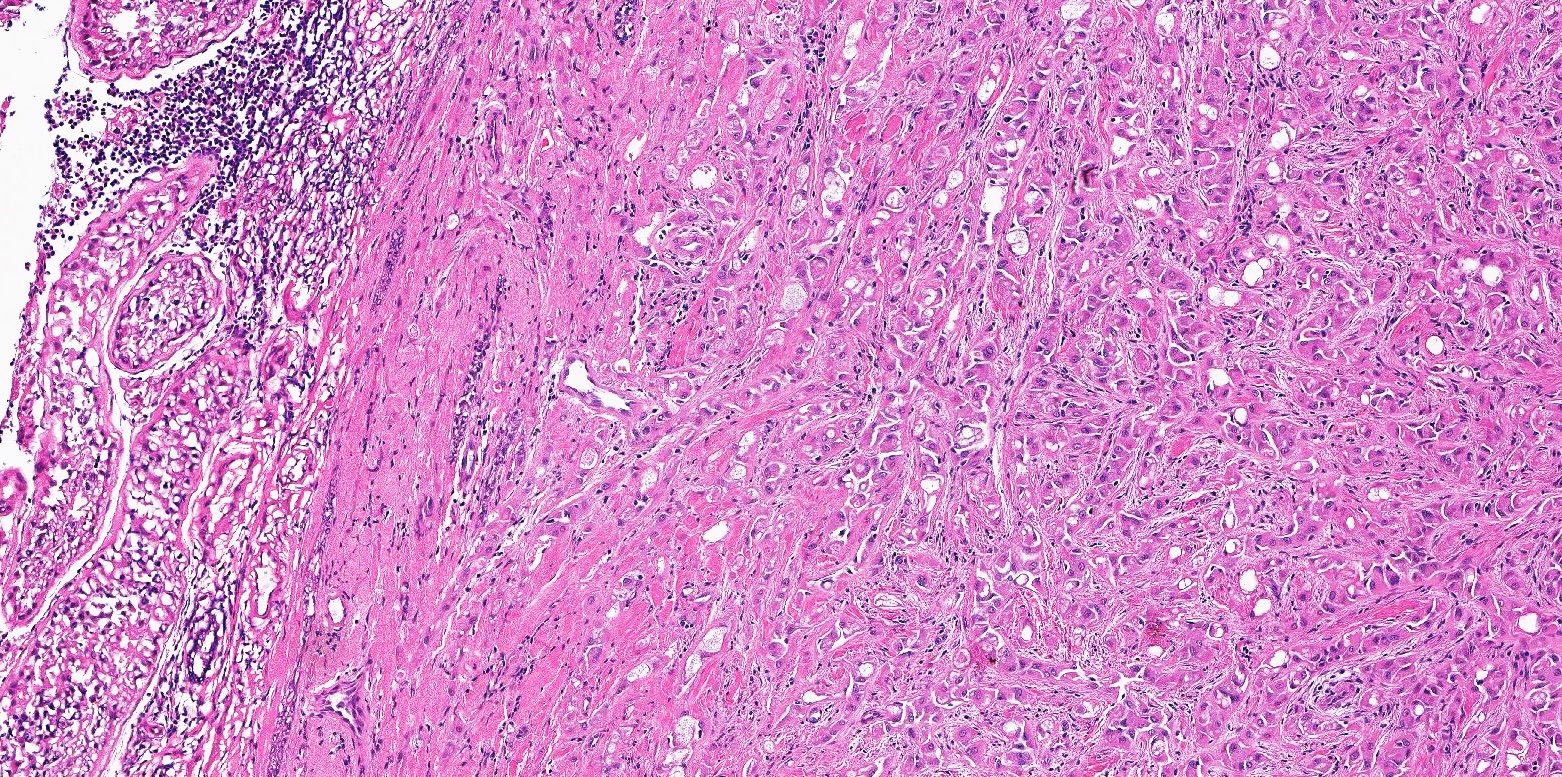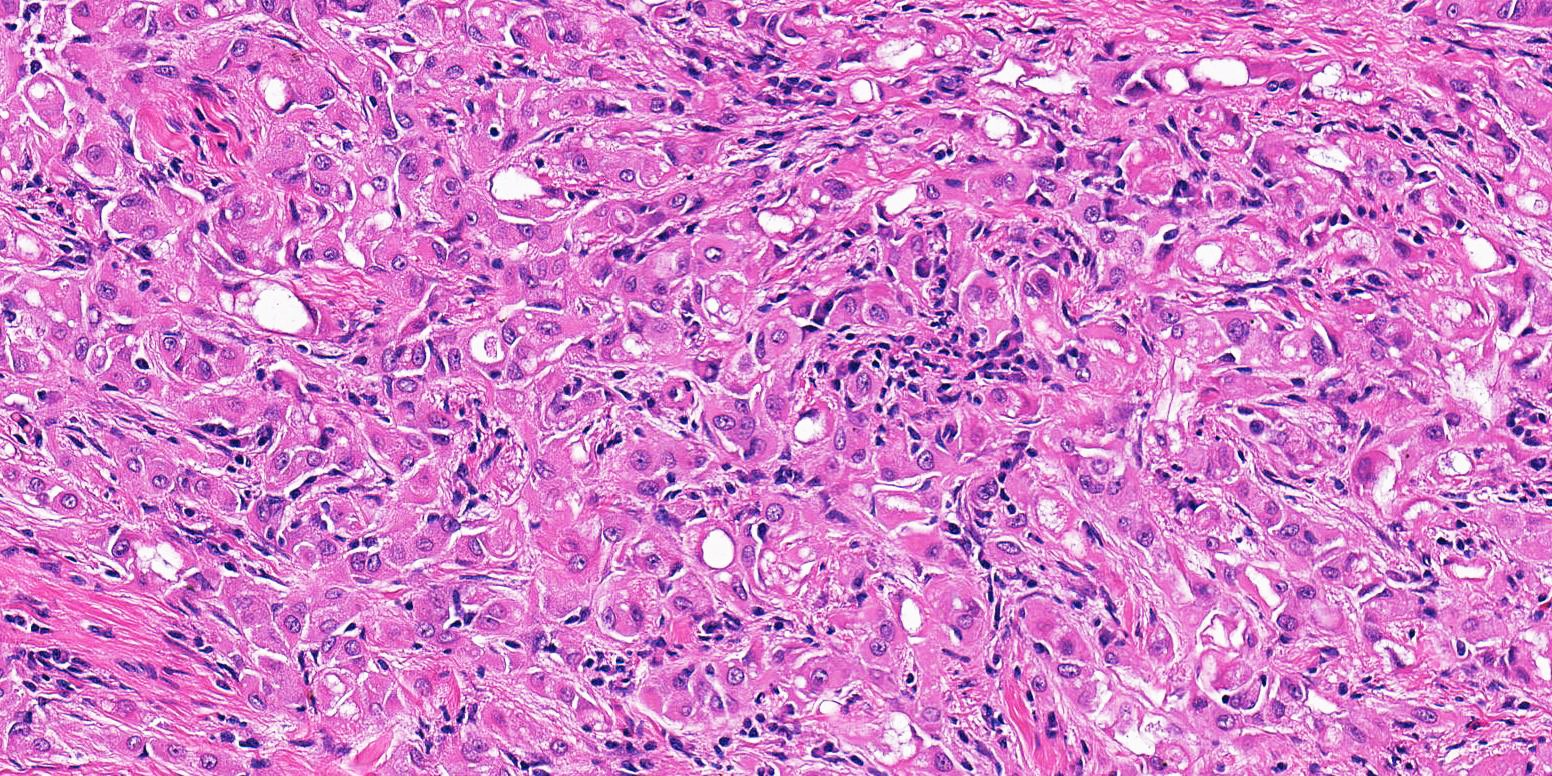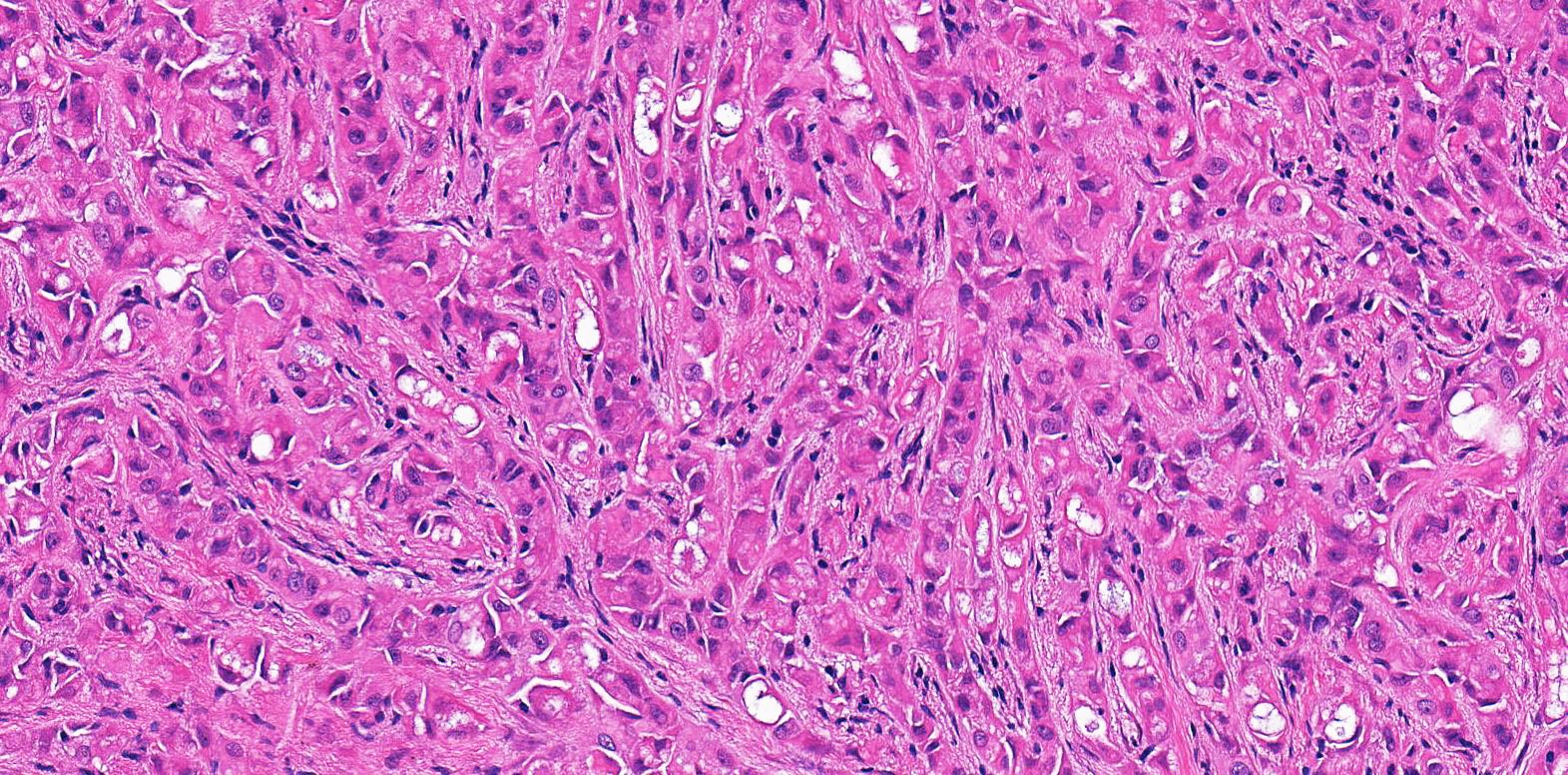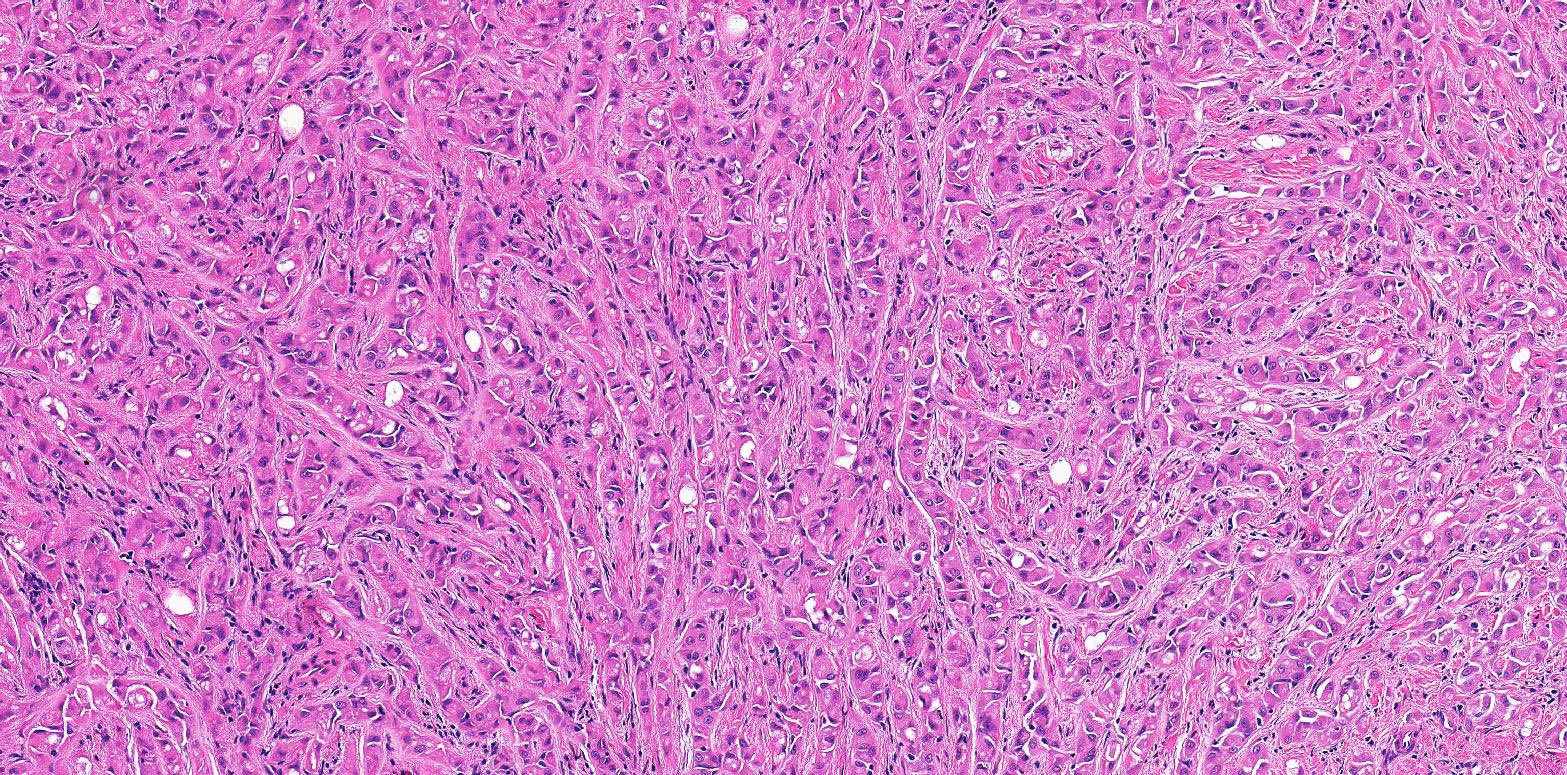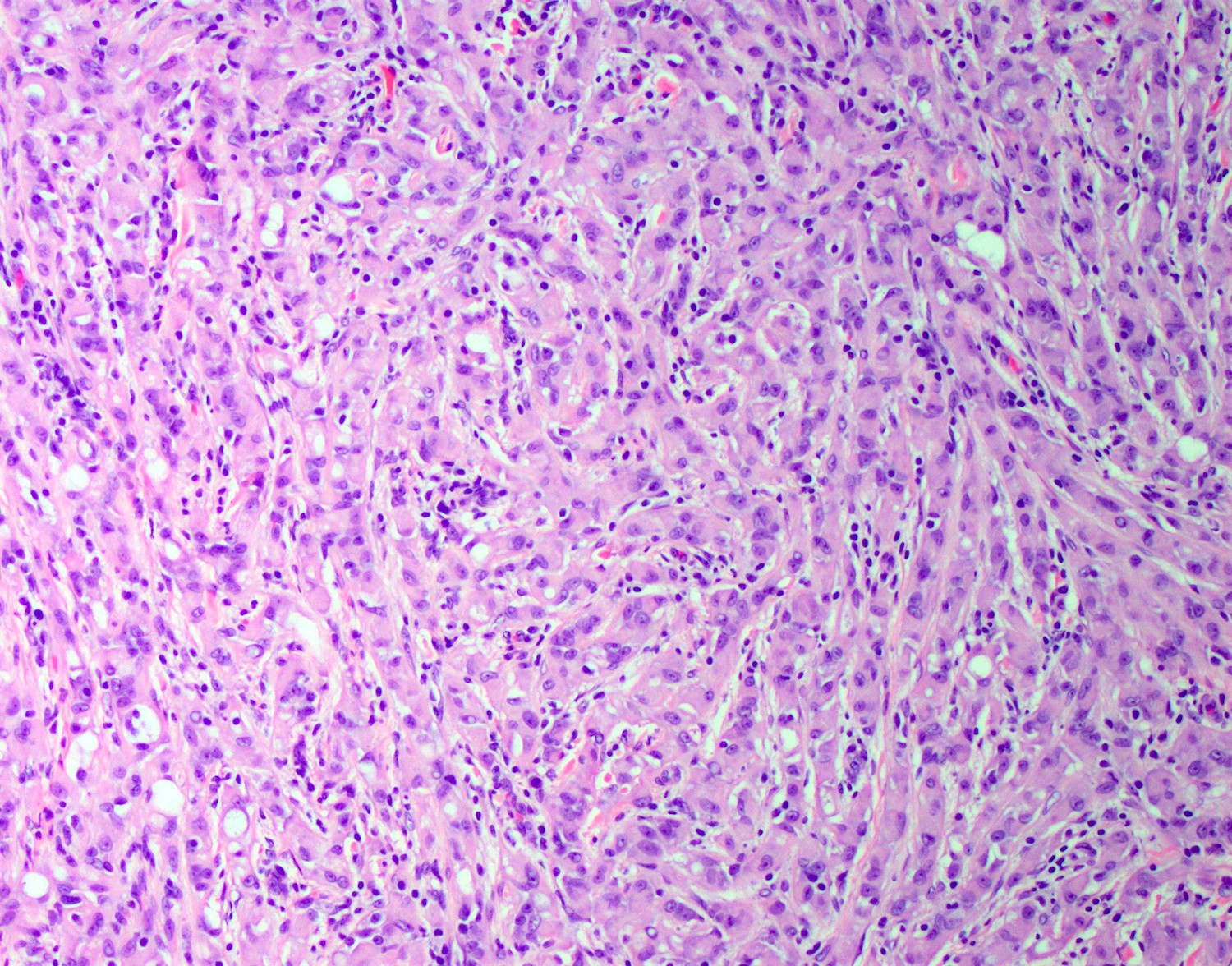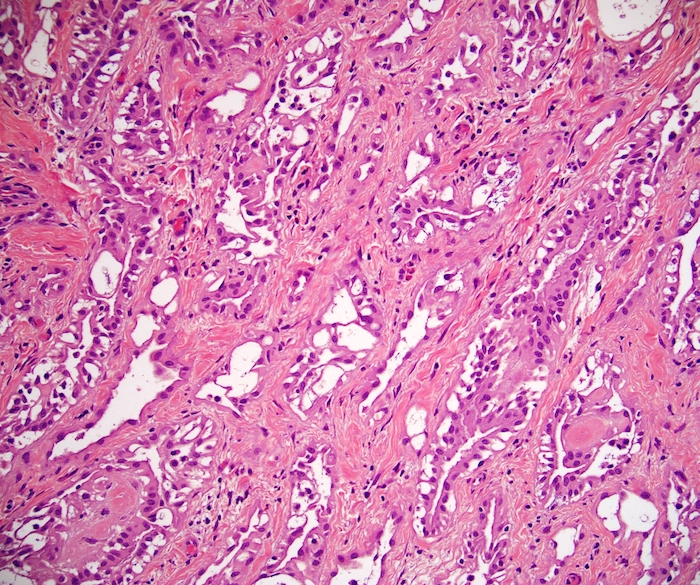Table of Contents
Definition / general | Essential features | ICD coding | Epidemiology | Sites | Pathophysiology | Etiology | Clinical features | Diagnosis | Laboratory | Radiology description | Radiology images | Prognostic factors | Case reports | Treatment | Gross description | Gross images | Frozen section description | Frozen section images | Microscopic (histologic) description | Microscopic (histologic) images | Virtual slides | Cytology description | Cytology images | Positive stains | Negative stains | Electron microscopy description | Molecular / cytogenetics description | Sample pathology report | Differential diagnosis | Additional references | Board review style question #1 | Board review style answer #1 | Board review style question #2 | Board review style answer #2 | Board review style question #3 | Board review style answer #3Cite this page: Findeis S, Huang H. Adenomatoid tumor. PathologyOutlines.com website. https://www.pathologyoutlines.com/topic/testisepidadenomatoid.html. Accessed April 18th, 2024.
Definition / general
- Benign tumor of mesothelial origin
- Accounts for about a third of all tumors of paratesticular area and 60% of benign tumors of paratesticular area (Mostofi: Tumors of the Male Genital System, 1st Edition, 1973)
Essential features
- Most common benign paratesticular tumor
- Usually based in the epididymis and well circumscribed
- Expresses markers typical of mesothelial origin
ICD coding
- ICD-10: D29.30 - benign neoplasm of unspecified epididymis
Epidemiology
Sites
- Testicular adnexa
Pathophysiology
- Not known
Etiology
- Not known
Clinical features
- Most patients present with a mass; rarely present with pain due to associated torsion (Am J Surg Pathol 2004;28:77)
Diagnosis
- Primarily made histologically
Laboratory
- Testicular tumor markers: normal
Radiology description
- Circumscribed, solid paratesticular mass
- Unable to distinguish benign versus malignant on sonography (Radiology 1997;204:43)
- Tumors of the tunica may be indistinguishable from a germ cell tumor by imaging
Prognostic factors
- Benign neoplasm
Case reports
- 12 year old boy with adenomatoid tumor from tunica albuginea (Case Rep Urol 2015;2015:935193)
- 32 year old man with infarcted adenomatoid tumor (Case Rep Urol 2013;2013:937689)
- 39 year old man with a painful, slowly enlarging left testicular mass (Case of the Month #491)
- 53 year old man with bilateral seminomas and adenomatoid tumor (Indian J Pathol Microbiol 2017;60:415)
- 55 year old man with distant history of epididymal adenomatoid tumor with paratesticular mesothelioma arising at previous tumor site (Int J Surg Case Rep 2013;4:460)
- 57 year old man with leiomyoadenomatoid tumor (Curr Urol 2014;7:195)
Treatment
- Surgical excision
- Intraoperative frozen section may be helpful to indicate testis sparing surgery
Gross description
- Typically paratesticular well circumscribed, white-tan firm nodule
- Almost always unilateral and solitary
- Generally firmer than seminoma (Mod Pathol 2005;18 Suppl 2:S131)
- Mostly less than 2 cm, rarely up to 5 cm (Eble: Pathology and Genetics of Tumours of the Urinary System and Male Genital Organs, 1st Edition, 2004)
- Most commonly occurs at lower or upper pole of the epididymis
- Less common sites include tunica albuginea and spermatic cord (Mostofi: Tumors of the Male Genital System, 1st Edition, 1973)
Gross images
Frozen section description
- May be confused for malignant mesothelioma on biopsy; gross correlation often needed
- Can have atrophic testes with fibrous stromal proliferation (Urology 2004;63:779)
Frozen section images
Microscopic (histologic) description
- Tubules, cords or small nests
- Composed of or lined with cuboidal cells
- Moderate to abundant eosinophilic cytoplasm with single to multiple vacuoles
- Signet ring cell morphology and lipoblast-like morphologies very common (Mod Pathol 2009;22:1228)
- Other patterns: adenoid, angiomatoid, cystic, glandular, oncocytic, solid, tubular (Mod Pathol 2009;22:1228)
- Thin bridging strands crossing glandular / tubular spaces (Mod Pathol 2009;22:1228)
- Peripheral lymphoid aggregates (Mod Pathol 2009;22:1228)
- Infiltrative growth common (Mod Pathol 2009;22:1228)
- Can become infarcted (Am J Surg Pathol 2004;28:77)
Microscopic (histologic) images
Contributed by Sarah Findeis, M.D., Stephanie J. Conrad, M.D., Ming Zhou, M.D.,
the Genitourinary Pathology Society (GUPS) and @katcollmd on Twitter
Cytology description
- Epithelioid, monolayered sheets or clusters of cells with eccentric, vesicular round to ovoid nuclei, granular chromatin and pale / vacuolated cytoplasm (J Cytol 2009;26:30, J Cytol 2013;30:65)
- Can have a background of naked nuclei as well as stromal cells (Acta Cytol 1989;33:6)
Positive stains
Negative stains
- MOC31 / BerEP4, CEA, B72.3, LEA.135, LeuM1, Factor VIII, CD34 (Histopathology 2000;36:109)
- SALL4 (Am J Surg Pathol 2009;33:1065)
- 34betaE12 weak expression in 25% (Histopathology 2000;36:109)
- Thrombomodulin EXCEPT (Histopathology 2000;36:109)
- Membranous staining for acinar adenomatoid tumor
- Scanty pale foci of cytoplasmic staining for solid adenomatoid tumors
- HBME1 and OC 125 EXCEPT (Histopathology 2000;36:109)
- Membranous staining of HBME1 and OC 125 for acinar adenomatoid tumors
- Intracytoplasmic staining with discrete granular clump for solid adenomatoid tumors
- p53 (Histopathology 2000;36:109)
Electron microscopy description
- Rich in cytoplasmic organelles and has superficial desmosomes with microvilli (Cancer 1972;30:244)
Molecular / cytogenetics description
- TRAF7 somatic missense mutations (Mod Pathol 2018;31:660)
Sample pathology report
- Testicle and spermatic cord, right, radical orchiectomy:
- Paratesticular adenomatoid tumor, 1.5 cm
- Margins widely free of tumor (> 5.0 cm)
- Unremarkable background testis, epididymis and spermatic cord
- Comment: The tumor is positive for AE1/3, WT1 and calretinin and is negative for SALL4 and inhibin.
Differential diagnosis
- Malignant mesothelioma:
- BAP1 loss (Appl Immunohistochem Mol Morphol 2020;28:67)
- HBME1+ (Histopathology 2000;36:109)
- Grossly larger and more infiltrative
- Metastatic adenocarcinoma:
- Positive for carcinoma markers
- Desmoplasia
- Both will stain with mucin but weaker for adenomatoid tumor and only in a minority of cases (Cancer 1974;34:306)
- Sertoli cell tumor:
- Leydig cell tumor:
- Vascular neoplasms (especially epithelioid hemangioma):
- Lining cells more plump and nuclei with irregular cleaved contours
- Yolk sac tumor:
- SALL4+, glypican 3+, AFP+
- Has more primitive nuclear features
- Rarely paratestis primary
- Leiomyoma:
- More cellular spindle cell proliferation
- Lacks tubular or glandular structures
- Cytokeratin- or focal, desmin+
- Liposarcoma:
- Cells with true adipocytic features
- Lipoblast may be present
- Negative for cytokeratin
Additional references
Board review style question #1
Board review style answer #1
D. These tumors are rarely identified within the testicular parenchyma. This is an adenomatoid tumor. They can be identified within both sexes. It occurs in the paratesticular region most commonly in the third to fourth decade. The tumor rarely involves the testicular parenchyma. If there is only intraparenchymal involvement, other primary parenchymal lesions need to be ruled out, such as a sex cord stromal tumors or germ cell tumors.
Comment Here
Reference: Adenomatoid tumor
Comment Here
Reference: Adenomatoid tumor
Board review style question #2
- A 36 year old man presents to his physician with a painless testicular mass. Imaging showed a well circumscribed solid mass arising from the tunica albuginea and not involving the testicular parenchyma. An orchiectomy is performed which shows a 2.0 cm unencapsulated white-tan circumscribed nodule. Histologic examination shows cords and tubules of cuboidal eosinophilic cells with vacuolated cytoplasm in the background of fibrous stroma, which infiltrates into the surrounding testicular tubules. What is the most likely staining pattern for this lesion?
- Calretinin +, EMA +, BAP 1+
- CK AE1/3 -, CD31 +, CD15 +
- OCT3/4 +, CEA+, S100+
- Vimentin -, CD99 +, calretinin -
Board review style answer #2
A. Calretinin +, EMA +, BAP 1+. This is an adenomatoid tumor, which is of mesothelial origin as the staining pattern suggests. The patient presentation of a small painless mass in a patient in the third - fourth decade is typical. Adenomatoid tumors rarely involve the testicular parenchyma and are the most common paratesticular tumor. Microscopic infiltration may be misinterpreted as invasion but may occur and the tumor still has a benign course.
Comment Here
Reference: Adenomatoid tumor
Comment Here
Reference: Adenomatoid tumor
Board review style question #3
- Which of the immunohistochemical stains, when positive, supports the diagnosis of adenomatoid tumor?
- AFP
- B72.3
- Calretinin
- CD34
- Inhibin
Board review style answer #3







